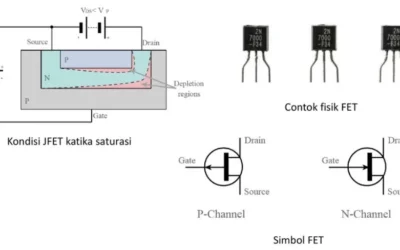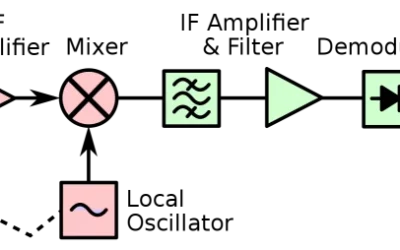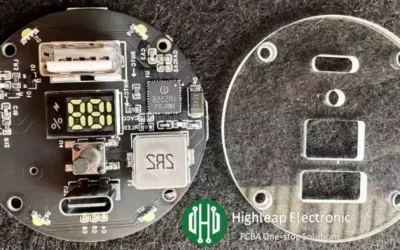Back to blog
China High Quality Hybrid PCB Manufacturer

Hybrid PCB-Rigid flexible PCB
Introduction
In the dynamic field of electronics, the demand for high-frequency applications continues to surge. This demand spans a variety of sectors, including telecommunications, radar systems, satellite communications, and wireless networking. The essential need for efficient and reliable high-frequency circuits has led to the growing popularity of hybrid printed circuit boards (PCBs). These advanced PCBs combine the strengths of traditional rigid PCBs with flexible circuit technology, offering a myriad of benefits for high-frequency applications. This comprehensive guide will delve into the intricacies of hybrid PCBs, examining their advantages, design considerations, and applications, and providing insights tailored to the needs of professionals in the electronics industry.
Understanding Hybrid PCBs
What Are Hybrid PCBs?
Hybrid PCBs, often referred to as rigid-flex PCBs, integrate both rigid and flexible circuit board technologies. The rigid sections provide structural stability and support for components, while the flexible sections facilitate efficient routing and interconnections within constrained spaces. This unique combination makes hybrid PCBs particularly advantageous for high-frequency applications.
Structure and Design
Hybrid PCBs typically consist of multiple layers, including both rigid and flexible substrates. The rigid sections are composed of standard PCB materials like FR4, while the flexible sections use materials such as polyimide. These materials are carefully selected to optimize performance, ensuring that the PCB can handle the demands of high-frequency signals and harsh operating environments.
Key Benefits of Hybrid PCBs in High-Frequency Applications
Improved Signal Integrity
Signal integrity is crucial in high-frequency applications. Hybrid PCBs excel in maintaining signal integrity by minimizing the number of connections and interconnects between components. This reduction in transitions and discontinuities helps to mitigate signal reflections, crosstalk, and other integrity issues that can compromise performance at high frequencies. The use of high-quality materials with low dielectric loss further enhances signal fidelity.
Enhanced Thermal Management
High-frequency circuits generate substantial heat, which can lead to performance degradation or component failure if not properly managed. Hybrid PCBs offer superior thermal management capabilities. The rigid sections can incorporate thermal vias and ground planes, which facilitate efficient heat dissipation. Meanwhile, the flexible sections allow for better airflow and cooling in confined spaces, ensuring that the PCB maintains optimal operating temperatures.
Increased Reliability and Durability
The combination of rigid and flexible sections in hybrid PCBs contributes to their overall reliability and durability. Rigid sections provide structural stability and protection for components, while flexible sections can withstand vibrations, shocks, and other environmental stresses. This robustness makes hybrid PCBs ideal for applications that require long-term reliability and can endure harsh conditions, such as aerospace, military, and industrial environments.
Space Optimization and Miniaturization
One of the most significant advantages of hybrid PCBs is their ability to optimize space and facilitate miniaturization. The flexible sections can be routed in three dimensions, making efficient use of available space within enclosures or housings. This is particularly beneficial in high-frequency applications where compact designs are often required, such as in portable communication devices, radar systems, and satellite electronics.
Reduced Weight and Cost
Compared to traditional PCB solutions, hybrid PCBs can offer weight and cost savings. By eliminating the need for complex interconnects and reducing the number of required layers, hybrid PCBs can be lighter and more cost-effective. This is particularly advantageous in industries where weight and cost are critical factors, such as aerospace and defense.
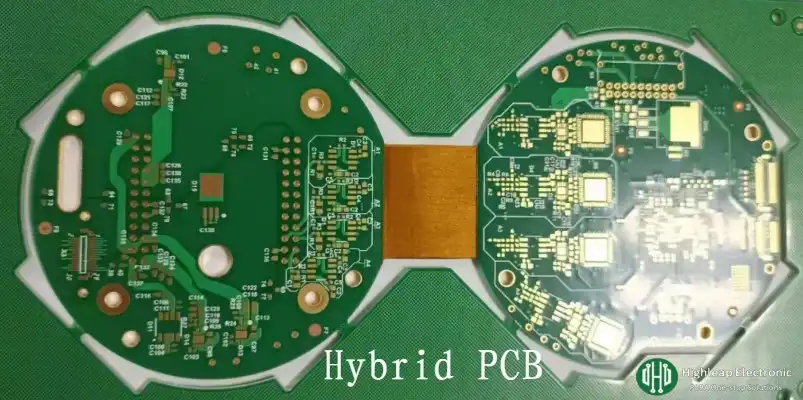
Hybrid PCB
Design Considerations for Hybrid PCBs in High-Frequency Applications
Material Selection
The choice of materials for both the rigid and flexible sections is critical to the performance of hybrid PCBs in high-frequency applications. Materials with low dielectric loss and high thermal conductivity are preferred to ensure optimal signal integrity and thermal management. Commonly used materials include FR4 for the rigid sections and polyimide for the flexible sections.
Impedance Matching
Proper impedance matching is essential to ensure efficient signal transmission and minimize reflections in high-frequency circuits. The design of the hybrid PCB must account for the different dielectric constants and impedance values of the rigid and flexible sections. This requires careful calculation and layout planning to maintain consistent impedance throughout the signal path.
Electromagnetic Interference (EMI) and Shielding
High-frequency circuits are susceptible to electromagnetic interference (EMI), which can degrade performance and cause signal integrity issues. Hybrid PCBs may require additional shielding or grounding techniques to mitigate EMI effects. This can include the use of ground planes, shielding layers, and careful layout practices to minimize EMI susceptibility.
Thermal Management Strategies
Effective thermal management strategies are crucial for the reliable operation of hybrid PCBs in high-frequency applications. Incorporating heat sinks, thermal vias, and airflow channels can help dissipate heat and prevent overheating. Additionally, the use of materials with high thermal conductivity and the strategic placement of components can further enhance thermal management.
Manufacturing Processes
The manufacturing processes for hybrid PCBs are more complex than those for traditional PCBs. Specialized equipment and techniques are required to ensure proper alignment, lamination, and interconnection between the rigid and flexible sections. Precision and attention to detail are paramount to achieving the desired performance and reliability.
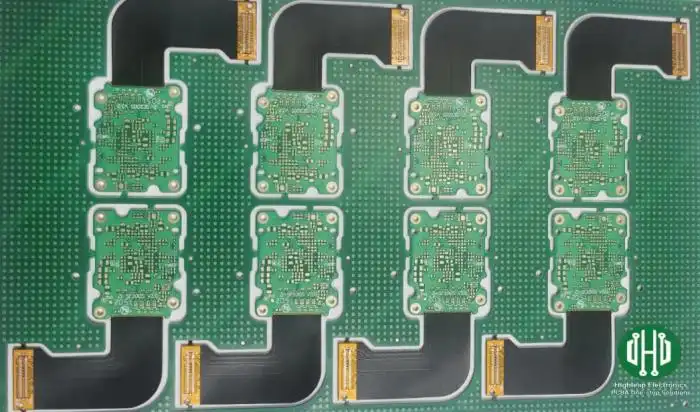
Hybrid PCB&Rigid flexible PCB
Applications of Hybrid PCBs in High-Frequency Systems
Hybrid PCBs have found widespread applications in various high-frequency systems across multiple industries. Some notable examples include:
-
-
Telecommunications
-
Aerospace and Defense
-
Automotive Electronics
-
Medical Devices
-
Internet of Things (IoT) and Wearable Devices
-
Comparison of Hybrid PCBs with Other PCB Technologies
To better understand the advantages of hybrid PCBs in high-frequency applications, it is helpful to compare them with other PCB technologies:
| PCB Technology | Advantages | Disadvantages |
|---|---|---|
| Rigid PCBs | – Structural stability – Simple manufacturing process – Cost-effective for low-density designs | – Limited routing flexibility – Challenges in miniaturization – Potential signal integrity issues at high frequencies |
| Flexible PCBs | – Excellent routing flexibility – Space optimization – Ability to withstand vibrations and bending | – Limited component density – Potential thermal management challenges – Susceptibility to damage in harsh environments |
| Hybrid PCBs | – Combination of structural stability and flexibility – Improved signal integrity – Enhanced thermal management – Increased reliability and durability – Space optimization and miniaturization – Reduced weight and cost | – More complex design and manufacturing processes – Higher initial cost due to specialized materials and techniques |
As illustrated, hybrid PCBs offer a unique combination of advantages that make them well-suited for high-frequency applications, outweighing the potential drawbacks in terms of design complexity and manufacturing processes.
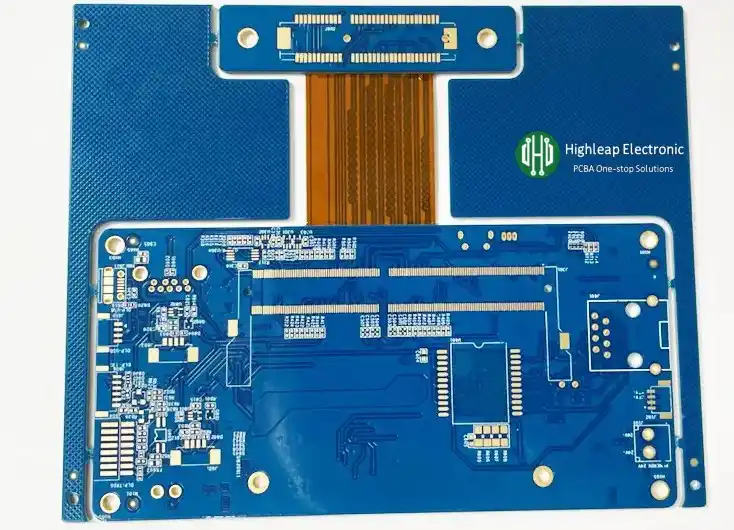
Blue solder mask Hybrid PCB
Conclusion
Hybrid PCBs represent a cutting-edge solution for high-frequency applications, addressing the challenges of signal integrity, thermal management, reliability, and space constraints. By combining the advantages of rigid and flexible circuit technologies, hybrid PCBs provide a versatile and efficient platform for a wide range of high-frequency systems. As the demand for high-frequency applications continues to grow, the adoption of hybrid PCBs is likely to increase, driven by their unique benefits and capabilities.
Highleap Electronic, as a leading manufacturer in the PCB industry, offers state-of-the-art hybrid PCB solutions tailored to meet the specific needs of high-frequency applications. With a commitment to quality, innovation, and customer satisfaction, Highleap Electronic is poised to support the evolving demands of the electronics industry, providing robust and reliable PCB solutions for the most challenging high-frequency environments.
This comprehensive guide has explored the myriad advantages of hybrid PCBs, detailed the critical design considerations, and highlighted their applications across various industries. By understanding the unique benefits and capabilities of hybrid PCBs, professionals in the electronics field can make informed decisions and leverage these advanced technologies to achieve superior performance in high-frequency applications.
FQA
1.What are the primary challenges in designing hybrid PCBs for high-frequency applications?
Designing hybrid PCBs for high-frequency applications presents several challenges, including maintaining precise impedance control, ensuring signal integrity over flexible and rigid sections, and effectively managing thermal dissipation. Additionally, designers must consider the mechanical stresses that flexible sections endure and incorporate robust materials and construction techniques to prevent failures.
2.How does the integration of flexible sections in hybrid PCBs impact electromagnetic compatibility (EMC)?
The integration of flexible sections in hybrid PCBs can impact electromagnetic compatibility (EMC) by altering the signal paths and introducing potential points of electromagnetic interference (EMI). To mitigate these effects, designers should use advanced shielding techniques, optimize the placement of ground planes, and carefully route high-frequency signals to minimize crosstalk and radiation.
3.What advanced materials are recommended for hybrid PCBs in high-frequency applications?
For high-frequency applications, advanced materials such as Rogers laminates, which offer low dielectric loss and high thermal conductivity, are recommended for the rigid sections. Polyimide or liquid crystal polymer (LCP) are preferred for the flexible sections due to their excellent thermal stability, flexibility, and low dielectric constant, which support high-frequency signal transmission.
4.How do hybrid PCBs enhance the performance of radar systems?
Hybrid PCBs enhance the performance of radar systems by providing superior signal integrity and thermal management. The rigid sections support high-speed data processing and power distribution, while the flexible sections allow for intricate antenna designs and compact, lightweight configurations. This combination ensures reliable and efficient operation in high-frequency radar applications.
5.What are the considerations for testing and quality assurance of hybrid PCBs used in critical applications?
Testing and quality assurance of hybrid PCBs for critical applications require rigorous methodologies, including automated optical inspection (AOI), X-ray inspection, and functional testing under environmental stress conditions. Additionally, electrical testing for impedance control, signal integrity, and thermal cycling tests are essential to ensure the hybrid PCB meets the stringent reliability and performance standards necessary for high-frequency and high-reliability applications.
Related Articles
Understanding Field-Effect Transistors (FETs) in PCB Design
Dive into the fundamentals of Field-Effect Transistors (FETs) and their critical role in PCB design.
Future Prospects and Challenges in Local Oscillator Development
Developing multi-function chips that integrate local oscillators(LOs) with other RF components, such as mixers, amplifiers, and filters, is an emerging trend.
Common Anode and Common Cathode 7 segment displays
This comprehensive guide delves into the intricacies of 7-segment displays, their types, functionalities, and design considerations in PCB layouts.
Take a Quick Quote


